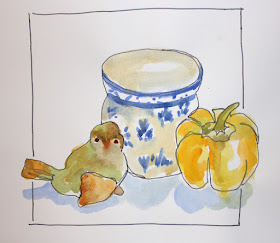We are all students and always will be as long as our minds and hearts remain open and curious. Art workshops provide creative opportunities to not only learn new skills but also rub shoulders with other artists and gain new ideas, encouragement and inspiration.
Negative painting practice after the workshop.
Brenda Swenson in Boone, NC
I had the delightful experience this past week of visiting Boone, North Carolina, for a five-day "Sketching in Watercolor" workshop hosted by Cheap Joe's Art Outlet, featuring award-winning artist, Brenda Swenson. I admire her watercolors and sketches and couldn't pass up the opportunity to learn from her when I discovered she was visiting the east to give a workshop.
Porch outside the class room--a place to retreat for breaks or to enjoy lunch.
Each day of the workshop we practiced drawing skills that will help us paint a subject from life. The first skill practiced, and our warm-up practice for each day, was continuous line contour drawing--drawing with a continuous line without lifting your pen. And yes, pen, not pencil. No erasing or correcting. We were encouraged to slow down and "see", and yet, each drawing had a time-limit and a timer running to keep our hands and minds moving. Three minutes were allowed for one object, six minutes for two objects, and nine for three. The objects were household items or "junk", any vase, tool, figurine, pitcher, anything that might be laying around the house or garage.
Above, a class exercise--combining elements from more than one photograph to create a sketch composition. Tombow water soluable burnt sienna pen with watercolor on Canson multi-media sketchbook paper.
The daily warm-ups accomplished so many things. Practice in concentrating, accepting the wobbles in our drawings, awareness of time, moving continuously without getting stuck on any one area, focus, and just getting it down no matter how imperfect. In fact, one of the mottos of class-- "perfect is boring". What we found as we looked at each other's work was that the wobbles contributed to the uniqueness, charm and style of each drawing.
Above, members of our class waiting to have our work critiqued. (I'm third from the left in the front row). Photo credit: Brenda Swenson
We learned as much from our critiques as we did from the art exercises and they were fun! Everyone's art is different and the variations in style and creativity are exciting. Brenda pointed out positives in each work and gave suggestions for improvements, providing great visual examples to aid memory.
For example, the white cloud in my sketching practice on tinted paper (above) was created with opaque paint. After pointing out the vignette design and how the light travels through the color of the tinted paper through the columns, Brenda mentioned that the white cloud wasn't needed. I looked at it later and realized that the cloud is not only not needed, it draws the eye away from the main subject which is the lovely columns. This is the value of practice and having someone else critique your work. We're often too close to our own work to be objective.

The continuous line contour drawings felt awkward to me, at first, and I initially wondered why I ever thought I could draw! Drawing is a skill that becomes rusty when not used! For me the additional challenge was a combination of new tools and the timer. With a timer going, I couldn't obsess about the details. I couldn't erase! This represented a huge leap forward. I have wanted to sketch as I travel but the stopper has always been "too little time". The skills we practiced were the very ones I needed to create possibilities for sketching in all types of circumstances.
Above, Brenda Swenson demonstrates her
negative painting technique.
In the classroom, a video camera was mounted to project the art demonstrations on a large screen so that while seated, members of the class could view the demonstrations. The images above and below are pictures of the screen during the demonstration.
Delicious catered lunches were enjoyed daily and for the eager student, Cheap Joe's art supply store was right in the next room open for business! Add a skilled and patient instructor to the mix and you have the ingredients for an ideal art vacation!

Tennessee artist Kay Alexander (left), Brenda Swenson and Vickie Henderson in Boone, NC.
Resources and information:
Brenda Swenson's website
Brenda's blog
Kay Alexander's website
Cheap Joe's Art Supplies




















